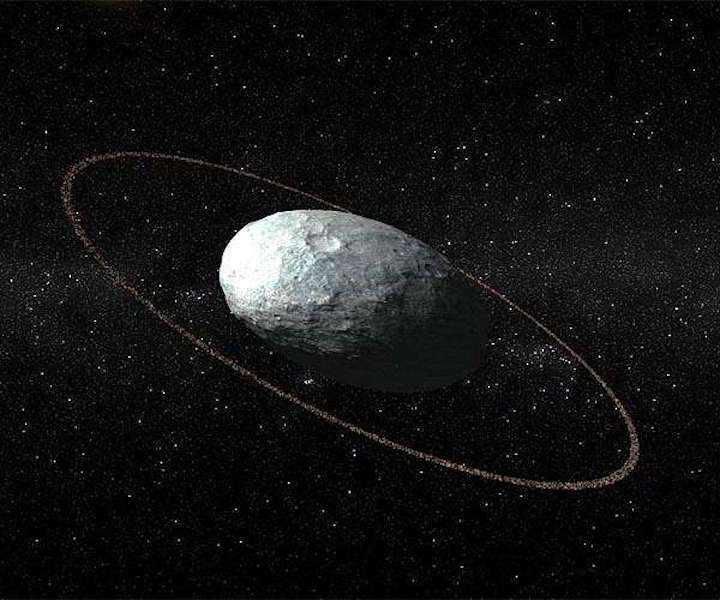9.05.2019

Discovered in 2004, Haumea is a dwarf planet located beyond Pluto's orbit in a region of the Solar System called the Kuiper Belt. Pluto was demoted from the category of fully fledged planets in 2006 because of the discovery of Haumea and other dwarf planets.
Haumea was officially recognized as a dwarf planet in 2008. Its ellipsoidal shape resembles that of the ball used in rugby or American football. It has two moons and a ring. Because of its ring, Haumea is a member of a group of Solar System objects comprising the planets Saturn, Uranus, Neptune and Jupiter, as well as the asteroids Chariklo and Chiron, which orbit between Jupiter and Neptune.
Haumea's ring has never been directly observed. Its existence was inferred in 2017 by an international group of astronomers who took detailed measurements of the light fluctuations as Haumea occulted (passed in front of) a star. In space, an occultation occurs when one object passes in front of another from an observer's perspective.
"The light from the star was observed from Earth as the star was occulted by Haumea. Its brightness decreased as Haumea passed in front of it, enabling the astronomers to obtain information about Haumea's shape," said Othon Cabo Winter, Full Professor at Sao Paulo State University's Engineering School (FE-UNESP) in Guaratingueta, Brazil.
"The star's light also faded when the ring passed in front of it, enabling them to obtain information on the ring as well."
The researchers who discovered the ring in 2017 suggested that its orbit around Haumea was very close to the 1:3 resonance region, meaning that ring particles make one revolution every three times Haumea rotates.
A new study by Winter, Tais Ribeiro and Gabriel Borderes Motta, who belong to UNESP's Orbital Dynamics and Planetology Group, shows that a degree of eccentricity would be required for this resonance to act on the ring particles.
According to Winter, the fact that the ring is narrow and practically circular prevents action by the resonance. However, the group identified a specific type of stable, almost circular, periodic orbit in the same region as Haumea's ring. A periodic orbit is an orbit that repeats over time.
"Our study isn't observational. We did not directly observe the ring. No one ever has," Winter said. The reason is that the ring is very tenuous and much too far-flung to be seen by the astronomic observatories here on Earth. The average distance between Haumea and the Sun is 43 times the distance between Earth and the Sun.
"Our study is entirely computational. Based on simulations using the available data on Haumea and the ring, subject to Newton's law of gravitation, which describes the motions of the planets, we concluded that the ring isn't in that region of space owing to the 1:3 resonance but owing to a family of stable periodic orbits," Winter said.
In an article published in Monthly Notices of the Royal Astronomical Society, the researchers explore the dynamics of individual particles in the region where the ring is located.
The research behind the paper was part of the Thematic Project "On the relevance of small bodies in orbital dynamics" funded by Sao Paulo Research Foundation - FAPESP and supported by the Brazilian federal government via CAPES, the higher education research council, and CNPq, the National Council for Scientific and Technological Development.
"The main aim of our research was to identify the structure of Haumea's ring in terms of the location and size of the stable regions. We also wanted to find the reason for the ring's existence. We were particularly interested in trying to understand the dynamic structure associated with its 1:3 resonance," Winter said.
Stable regions
The researchers used the Poincare surface-of-section technique to analyze the dynamics of the region in which the ring is located. By simulating the trajectories of particles in the region, they generated computer graphics (sections) displaying stable areas represented as islands (closed curves) and unstable areas represented as irregularly distributed points.
The islands of stability found to be due to the 1:3 resonance had highly eccentric orbits, more so than would be compatible with the ring (narrow and circular).
"On the other hand, we detected islands of stability in the same area but with trajectories of low eccentricity that were compatible with the ring. These islands were found to be due to a family of periodic orbits," Winter said.
Haumea has a diameter of 1,456 km, less than half the diameter of Mars, and an oval shape that makes it twice as long as it is wide. It takes 284 years to go round the Sun. The dwarf planet is so far away, and the sunlight that reaches it so weak, that its surface temperature is minus 223 C.
Haumea's moons Namaka and Hi'iaka were detected by the giant lenses of one of the observatories atop Hawaii's dormant volcano Mauna Kea. The dwarf planet is named for the Hawaiian goddess of fertility and childbirth, and its moons are named for Haumea's daughters. They are believed to have resulted from a collision between the dwarf planet and some other body.
Haumea completes a rotation in under four hours, spinning faster than any other known equilibrium body in the Solar System. This may have to do with a violent past.
Astronomers think Haumea was originally much like Pluto when the Solar System was formed. Billions of years ago, a large object may have collided with Haumea, expelling most of its surface ice and making it spin much faster than the other dwarf planets.
Quelle: SD

